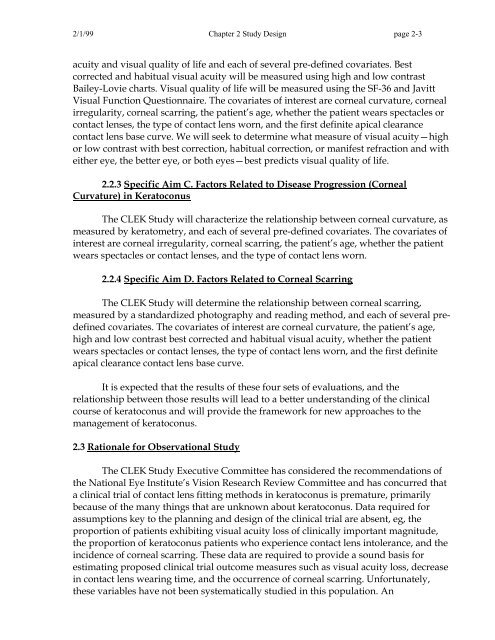OM t of c.iii - Vision Research Coordinating Center - Washington ...
OM t of c.iii - Vision Research Coordinating Center - Washington ...
OM t of c.iii - Vision Research Coordinating Center - Washington ...
Create successful ePaper yourself
Turn your PDF publications into a flip-book with our unique Google optimized e-Paper software.
2/1/99 Chapter 2 Study Design page 2-3<br />
acuity and visual quality <strong>of</strong> life and each <strong>of</strong> several pre-defined covariates. Best<br />
corrected and habitual visual acuity will be measured using high and low contrast<br />
Bailey-Lovie charts. Visual quality <strong>of</strong> life will be measured using the SF-36 and Javitt<br />
Visual Function Questionnaire. The covariates <strong>of</strong> interest are corneal curvature, corneal<br />
irregularity, corneal scarring, the patient’s age, whether the patient wears spectacles or<br />
contact lenses, the type <strong>of</strong> contact lens worn, and the first definite apical clearance<br />
contact lens base curve. We will seek to determine what measure <strong>of</strong> visual acuity—high<br />
or low contrast with best correction, habitual correction, or manifest refraction and with<br />
either eye, the better eye, or both eyes—best predicts visual quality <strong>of</strong> life.<br />
2.2.3 Specific Aim C. Factors Related to Disease Progression (Corneal<br />
Curvature) in Keratoconus<br />
The CLEK Study will characterize the relationship between corneal curvature, as<br />
measured by keratometry, and each <strong>of</strong> several pre-defined covariates. The covariates <strong>of</strong><br />
interest are corneal irregularity, corneal scarring, the patient’s age, whether the patient<br />
wears spectacles or contact lenses, and the type <strong>of</strong> contact lens worn.<br />
2.2.4 Specific Aim D. Factors Related to Corneal Scarring<br />
The CLEK Study will determine the relationship between corneal scarring,<br />
measured by a standardized photography and reading method, and each <strong>of</strong> several predefined<br />
covariates. The covariates <strong>of</strong> interest are corneal curvature, the patient’s age,<br />
high and low contrast best corrected and habitual visual acuity, whether the patient<br />
wears spectacles or contact lenses, the type <strong>of</strong> contact lens worn, and the first definite<br />
apical clearance contact lens base curve.<br />
It is expected that the results <strong>of</strong> these four sets <strong>of</strong> evaluations, and the<br />
relationship between those results will lead to a better understanding <strong>of</strong> the clinical<br />
course <strong>of</strong> keratoconus and will provide the framework for new approaches to the<br />
management <strong>of</strong> keratoconus.<br />
2.3 Rationale for Observational Study<br />
The CLEK Study Executive Committee has considered the recommendations <strong>of</strong><br />
the National Eye Institute’s <strong>Vision</strong> <strong>Research</strong> Review Committee and has concurred that<br />
a clinical trial <strong>of</strong> contact lens fitting methods in keratoconus is premature, primarily<br />
because <strong>of</strong> the many things that are unknown about keratoconus. Data required for<br />
assumptions key to the planning and design <strong>of</strong> the clinical trial are absent, eg, the<br />
proportion <strong>of</strong> patients exhibiting visual acuity loss <strong>of</strong> clinically important magnitude,<br />
the proportion <strong>of</strong> keratoconus patients who experience contact lens intolerance, and the<br />
incidence <strong>of</strong> corneal scarring. These data are required to provide a sound basis for<br />
estimating proposed clinical trial outcome measures such as visual acuity loss, decrease<br />
in contact lens wearing time, and the occurrence <strong>of</strong> corneal scarring. Unfortunately,<br />
these variables have not been systematically studied in this population. An
















